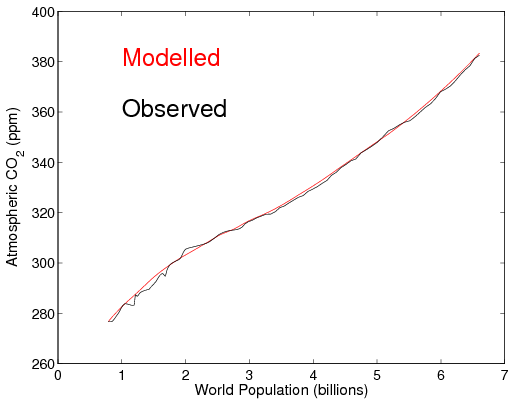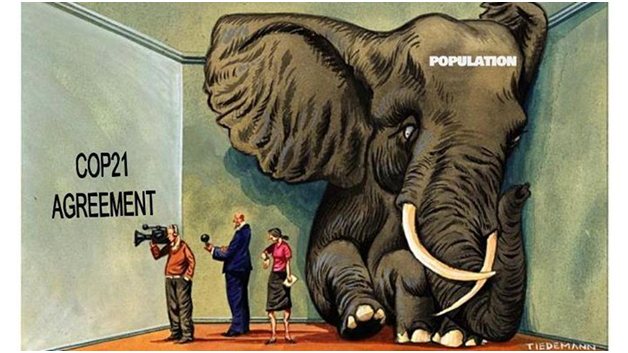Population Ignored Yet Again; This Time at Recent Paris Talks
Published on January 18th, 2016
Every human being on Earth emits carbon dioxide (CO2) and other greenhouse gases (GHGs), both directly and indirectly. Every time each of the 7.4 billion of us alive today exhales – trillions of daily exhalations in aggregate – we add a tiny net increment of CO2 to the atmosphere because of the physiological process of respiration in which all animals (and plants too) engage.
 For that matter, each of tens of billions of human farts emitted daily – consisting of about 7 percent methane (CH4), a far more potent GHG, molecule for molecule, than CO2 – also contributes to direct anthropogenic GHG loading.
For that matter, each of tens of billions of human farts emitted daily – consisting of about 7 percent methane (CH4), a far more potent GHG, molecule for molecule, than CO2 – also contributes to direct anthropogenic GHG loading.
But these net inputs of GHGs – part of the “exhalation of the Earth” – so well captured in the annual rise-and-fall of the atmospheric CO2 concentration as measured and graphed by the Mauna Loa Observatory in Hawaii (the so-called Keeling curve), are not the main cause of the inexorable upward slope of that curve superimposed on the annual cycle.
The main cause of that is massive dependence of modern, industrial economies upon the fossil fuels – oil, natural gas and coal – which has skyrocketed over the last two centuries.
As Australian geologist/mining engineer Simon Michaux, Ph.D., writes in the new book Sustainable Futures: Linking population, resources and the environment:
“The human population has increased and the per capita energy consumption has increased. These two patterns together show that consumption of non-renewable natural energy resources has increased 45 times in the last 150 years, while the planet we live on is a dynamically adjusting and ultimately a very stable finite system.”
Approximately 85 percent of the world’s energy now comes from these fossil fuels. Whenever fossil fuels are burned to produce the energy needed to run a power plant or a car or a hundred other fuel-guzzling machines, CO2 is an inevitable byproduct of the chemical process. By weight, each of the fossil fuels consists predominantly of carbon, combined with hydrogen and other elements; upon combustion, that carbon combines with oxygen in the air to produce CO2 – and release energy, the ability to do work.
The international committee of climatologists and other earth scientists known as the Intergovernmental Panel on Climate Change (IPCC) acknowledges that population growth is helping force the increases in emissions that cause global warming and climate change. In its Fourth Assessment Report, for example, the IPCC stated:
 |
| Courtesy Brian Sanderson, PhD
|
“GDP/per capita and population growth were the main drivers of the increase in global emissions during the last three decades of the 20th century.”
The modeled and observed relationship is depicted in the graph to the right. Global human population is shown on the horizontal (x) axis and atmospheric CO2 concentration in parts per million (ppm) is shown on the vertical (y) axis. The steady upward slope indicates that as population increases, the atmospheric CO2 concentration increases in tandem, if not lockstep.
The global scientific community, by and large, understands that population growth must be halted or reversed if we are to successfully curb GHG emissions. As one leading climate scientist at the Scripps Institution of Oceanography in San Diego told me in recent days: “…growing human population and GDP have been drivers of climate change and will continue to be drivers.”
 However, the climate negotiations (COP21) concluded in France last month, and the accord or agreement which resulted – hailed by many politicians, diplomats and enviros as a giant step forward while excoriated by some critics as the triumph of hope, hype and empty promises over action – excluded any mention at all of the need to halt population growth. Population growth was the proverbial elephant in the room: an enormous, overlooked presence.
However, the climate negotiations (COP21) concluded in France last month, and the accord or agreement which resulted – hailed by many politicians, diplomats and enviros as a giant step forward while excoriated by some critics as the triumph of hope, hype and empty promises over action – excluded any mention at all of the need to halt population growth. Population growth was the proverbial elephant in the room: an enormous, overlooked presence.
Why?
Why do the politicians and negotiators and even most ardent climate activists ignore scientists and one of the principal causes of climate change?
Lack of political will and consensus. Population continues to be such a polarizing issue among enough pro-growth, pro-fertility, misogynistic special interests around the world that even those who acknowledge its role are not willing to risk torpedoing a watered-down, lowest-common-denominator agreement by trying to force its inclusion. It’s a “nonstarter,” a “deal killer.”
Yet all the cheering that erupted when a deal was inked in overtime rings hollow when, as George Plum of Vermonters for Sustainable Population puts it:
“It’s hard if not impossible to reduce our total carbon footprint when we are adding more footprints.”
Each year the planet adds more than 80 million additional carbon footprints, and the U.S. about 2.5 million new footprints. Most U.S. population growth is due to swollen, unsustainable levels of legal and illegal immigration encouraged by our president, ethnic and business interests, and plutocrats. Democratic politicians covet illegal immigrants – aka “undocumented Democrats” – while the Republican establishment craves cheap, docile labor and ever more consumers.
President Obama enthusiastically gushes that the United States will be a leader in fighting climate change by reducing its own GHC emissions. To reiterate Mr. Plumb’s remark: “It’s hard if not impossible to reduce our total carbon footprint when we are adding more footprints.”
 |
|
Climate catastrophe? Bridge destroyed by Hurricane Katrina on
U.S. Hwy. 90 between Biloxi and Ocean Springs, Mississippi, 2005.
|
In advocating amnesty for illegal aliens, welcoming Central Americans into the country with open arms, and pushing for high levels of legal immigration, Obama promotes perpetual population growth in the U.S., undermining his own empty climate rhetoric and goals by pushing for colossal, unending, immigration-driven, and GHG-emitting population growth.
The economic and environmental implications of anthropogenic climate change are deadly serious, but in its unwillingness to tackle population growth (and other issues, such as binding commitments), Paris proves once again that most governments and people are not serious, not up to the challenge.
Not yet. By the time they come around, I worry that it may be too late. Irreversible climate tipping points, or points of no return, may have already been passed.




